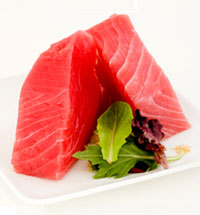Eating tuna sushi proved to be hazardous to health
By Margarita Snegireva. Experts tested sushi at 20 New York restaurants and reported that they contain an unacceptable amount of mercury which can produce harmful effects on people’s health.

Sushi from 5 of the 20 places had mercury levels so high that the Food and Drug Administration could take legal action to remove the fish from the market.
“No one should eat a meal of tuna with mercury levels like those found in the restaurant samples more than about once every three weeks," said Dr. Michael Gochfeld, professor of environmental and occupational medicine at the Robert Wood Johnson Medical School in Piscataway, N.J.
Fish and shellfish have a natural tendency to concentrate mercury in their bodies, often in the form of methylmercury, a highly toxic organic compound of mercury. Species of fish that are high on the food chain, such as shark, swordfish, king mackerel, albacore tuna, and tilefish contain higher concentrations of mercury than others. This is because mercury is stored in the muscle tissues of fish, and when a predatory fish eats another fish, it assumes the entire body burden of mercury in the consumed fish. Since fish are less efficient at depurating than accumulating methylmercury, fish-tissue concentrations increase over time. Thus species that are high on the food chain amass body burdens of mercury that can be ten times higher, or more, than the species they consume. This process is called biomagnification. The first occurrence of widespread mercury poisoning in humans occurred this way in Minamata, Japan, now called Minamata disease.
The complexities associated with mercury transport and environmental fate are described by USEPA in their 1997 Mercury Study Report to Congress. Because methylmercury and high levels of elemental mercury can be particularly toxic to unborn or young children, organizations such as the U.S. EPA and FDA recommend that women who are pregnant or plan to become pregnant within the next one or two years, as well as young children avoid eating more than 6 ounces (one average meal) of fish per week. In the United States the FDA has an action level for methyl mercury in commercial marine and freshwater fish that is 1.0 parts per million (ppm), and in Canada the limit for the total of mercury content is 0.5 ppm.
Species with characteristically low levels of mercury include shrimp, tilapia, salmon, pollock, and catfish (FDA March 2004). The FDA characterizes shrimp, catfish, pollock, salmon, and canned light tuna as low-mercury seafood, although recent tests have indicated that up to 6 percent of canned light tuna may contain high levels.
Subscribe to Pravda.Ru Telegram channel, Facebook, RSS!




